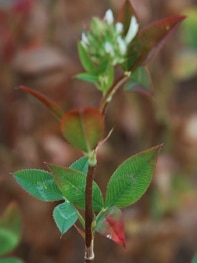Arrowleaf clover is a cool-season annual that is highly productive in fall and spring and a top-choice forage for whitetails, especially when does are carrying fawns and bucks are about to begin antler growth. Though it’s an annual, arrowleaf clover is a heavy re-seeder – with the right management, you can get several seasons of production out of one planting.
This plant is typical of most clovers with three leaflets. Each leaflet is arrow-shaped with a large white “V” mark. Leaves and stems are generally smooth and plants can obtain heights of four feet or more. In late spring, Arrowleaf clover produces clusters of white flowers with a light tinge of pink or purple. Growth normally occurs until hot weather hits in late June or July in most areas. The plant then disperses an abundance of seeds for future germination.
Soil Preparation
Arrowleaf clover can grow well on a wide variety of soils, but does best on soils that are well-drained. It can be sown in early September in more northern climates and early to mid-October in the south. Soil preparation is critical to successfully establish this crop. Soil test early to determine the fertility requirements and soil pH. Like most clovers, Arrowleaf does best on a soil pH 6.0-6.5. If agricultural lime is needed, it should be applied several months before planting to help adjust the pH.
 Planting
Planting
Soil should be deep tilled or plowed and then lightly disked or dragged to smooth the seed bed. A common mistake in planting clover is burying the seed too deep which will gravely affect the germination. Clover should not be planted more than 1/8-inch deep. Prior to planting, seed should be inoculated with the correct strand of Rhizobium bacteria (strain O). One small packet of inoculant will easily treat fifty pounds of Arrowleaf seed. Although it’s not mandatory, I like to use a sticker solution such as sugar water or a cola soft drink. Put the seed in a bucket and then add the inoculant along with a few ounces of the sugary liquid. Mix it well with a stick or your hand and allow it to dry a bit before you put it into the seeder. Broadcast ten to fifteen pounds of seed per acre or drill seed at a rate of 5-10 lb/acre. Seed can then be dragged lightly with a spring toothed harrow, a section of chain linked fence or a cultipacker.
Follow-Up
Continue to maintain the pH at a level of 6.0-6.5 to help ensure survival of the future germinating seed. Although some nitrogen will be beneficial for the initial planting, clover is a legume crop and will manufacture its own nitrogen in the future. You will however need to provide the proper level of phosphorus and potassium, as well as micro-nutrients as determined by your soil test. Mow the clover plot close to the ground in late summer to allow light to penetrate and new seeds to germinate in the fall.
Varieties
There are a couple of Arrowleaf clover varieties around including ‘Amclo’ and ‘Meechee’ but ‘Yuchi’ is perhaps the one most often used in food plots.
Arrowleaf mixes well with cereal grains. I go into detail on these potential mixes, and my own experiences with arrowleaf clover in my deer food plots, in the full profile in Quality Whitetails magazine, the journal for QDMA members.

 Planting
Planting